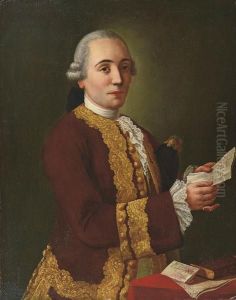Giuseppe Ceccarini Paintings
Giuseppe Ceccarini was an Italian artist and painter born in 1848 in Urbino, Italy, a city renowned for its rich history and cultural heritage, particularly during the Renaissance. Ceccarini's early life and education were deeply influenced by this artistic environment, which was instrumental in shaping his artistic career. He pursued his passion for art from a young age, honing his skills and absorbing the influences of the Renaissance masters who had left an indelible mark on his hometown. Despite the limited information about his early training, it is evident that Ceccarini was deeply committed to his craft and sought to contribute to the rich tapestry of Italian art.
Throughout his career, Ceccarini primarily focused on religious and historical themes, which were prevalent in the Italian artistic tradition. His works were characterized by their detailed realism, vibrant color palette, and the emotional depth with which he portrayed his subjects. Ceccarini's paintings often reflected his deep reverence for the past and a desire to connect contemporary viewers with the spiritual and historical narratives that shaped Italian identity. He participated in various exhibitions, gaining recognition and accolades for his contributions to the Italian art scene.
In addition to his paintings, Ceccarini was also known for his contributions to the restoration and preservation of art. Living in a country with an abundance of historical artworks and structures, he recognized the importance of maintaining this cultural heritage for future generations. His efforts in this area further demonstrated his deep love for Italian art and history.
Ceccarini's legacy is not just in the works he left behind but also in his influence on the generations of artists who followed. He remained active in the Italian art community until his death in 1924. Though perhaps not as widely known internationally as some of his contemporaries, Ceccarini's work continues to be appreciated for its beauty, technical skill, and historical significance. His contributions to Italian art are a testament to his lifelong dedication to capturing the essence of his nation's culture and history.
